Content created: 2013-07-15
File last modified:

Early Chinese Bronzes
A Beginner's Guide
Page Outline
- Introduction (Read this!)
- Generic Terms
- Prefixes
- Other Generic Terms
- Solid Food
- Food Preparation
- Containers for Cooked Grain
- Other Concave Vessels for Food Presentation
- Flat Vessels for Food Presentation
- Vessels for Liquids
- Vessels for Drinking or Pouring Libations
- Utility Vessels for Liquids
- Vessels for Presenting or Storing Liquids
- Vessels Probably Used as Flower Vases
- Other Common Bronze Implements
- Incense Burners
- Musical Instruments
- Miscellaneous Tools
- Bronze Weapons
- Sources
Alphabetical Index of Bronze Types
ān 盦,
bēi 杯,
bǐ 匕,
biān 笾,
biān qìng 编磬,
biān zhōng 编钟,
bō 钵,
bù 瓿,
chǎn 铲,
chéng 盛,
chí 匙,
chún 錞,
dāo 刀,
dēng 灯,
dēng 登,
dǐng 鼎,
dǒu 斗,
dòu 豆,
duān 端,
duì (pot) 敦,
duì (weapon) 镦,
fāng 方 ,
fāng 钫 ,
fǒu 缶,
fū 鈇,
fǔ 簠,
fù 鍑 ,
gāng 缸,
gǎo 镐,
gē 戈,
gōng 觥,
gōu 钩,
gū 觚,
guàn (pot) 罐,
guàn (washpan) 盥,
guāng 觥,
guǐ 簋,
hé (box) 盒,
hé 盉,
hú 壶,
jiǎ 斝,
jiàn (arrow) 箭,
jiàn (ice bowl) 鉴,
jiàn (mirror) 鉴,
jiàn (sword) 剑,
jiāo 浇,
jiǎo 角,
jué 爵,
kuī 盔,
léi 罍,
lì 鬲,
lián 奁,
liàng 量,
lú 炉,
máo 茅,
mǐn 皿,
náo 铙,
niú 牛,
ōu 瓯,
pán 盘,
pén (generic basin) 盆,
pén (wash basin) 盆,
píng 瓶,
pǒu 瓿,
sān jiǎo 三脚,
sì 兕,
sháo 勺,
shòu 兽,
shuǐ 水,
wǎn 碗,
wèng 瓮,
xī 牺 ,
xǐ 洗,
xiàng 象,
xín 鬵,
xíng 铏,
xǔ 盨 ,
xūn 熏,
yǎn 甗,
yí 彝,
yí 匜,
yīng 罃,
yǒu 卣,
yú 盂,
yuè 钺,
zào 灶,
zèng 甑,
zhī 巵,
zhì 觯,
zhōng (vessel) 钟,
zhōng (bell) 钟,
zhōu 舟,
zhù 注.
zú 足,
zūn 尊,
zūn 樽,
A. Introduction (Read this!)
The Bronze Age. The ability to manipulate metal ores to produce useful tools is one of the major steps in the development of human civilization. It is the reason why archaeologists stop using the term "Neolithic" and start referring to societies with metal as living in the "Bronze Age" or the "Iron Age."
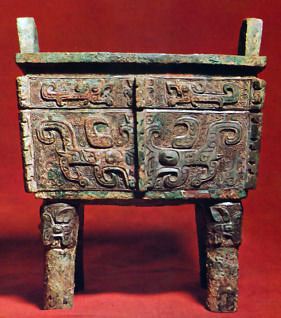
Copper (and bronze, an alloy of copper and tin) can be worked at lower temperatures than iron, but in most of the world copper ore is less readily available and the finished products more fragile. Iron ore is far more widely found and iron is far stronger than copper, but much greater heat is required to work it. In general, copper was made before bronze, and bronze was used before iron.
Separate essays on this web site are devoted to Ancient Metallurgy and to The Metal Ages. The important point for present purposes is that in most parts of the world copper and bronze objects were expensive and more showy than useful, especially when they contained lead, which facilitated casting but softened the resultant bronze. In contrast, later iron was strong enough and cheap enough to be used for agricultural and building tools and for weaponry in large enough quantities that huge and lethal armies could be equipped.
Bronze & Glory.
Throughout the ancient world, the primary role of bronze objects was as symbols of elite status. In the hierarchical world of early dynastic China, nearly all bronze production served this purpose, and immense energy was exerted to make bronze objects magnificent.
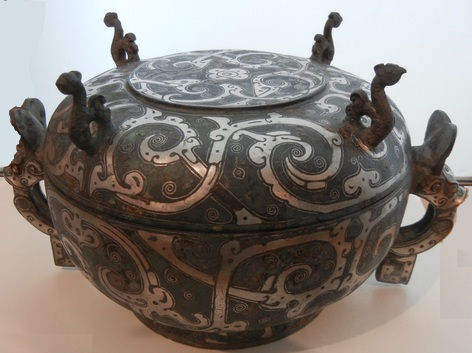 Bronze was developed to a very high level of technical and artistic sophistication in Shāng 商 and Zhōu 周 times in China —periods 03 and 04, roughly the millennium and a half from 1750-250 BC— but the objects made were only rarely of much use in the work-a-day world. Magnificence, instead, was the order of the day, or more exactly the centuries. Some, like the guǐ 簋 shown here, were even inlayed with silver or gold.
Bronze was developed to a very high level of technical and artistic sophistication in Shāng 商 and Zhōu 周 times in China —periods 03 and 04, roughly the millennium and a half from 1750-250 BC— but the objects made were only rarely of much use in the work-a-day world. Magnificence, instead, was the order of the day, or more exactly the centuries. Some, like the guǐ 簋 shown here, were even inlayed with silver or gold.
Most of these bronze objects were, in theory at least, intended for use in rituals, nearly always for the preparation or presentation of offerings of food, drink, flowers, or incense, and nearly always directed to ancestors.
In fact, of course, a fine piece of bronze would have spent most of its time displayed in its owner's display cabinet, silently proclaiming his importance. In some cases, bronzes became the rich furnishings of tombs, where they were, of course, still involved with ancestor worship, but on the receiving end!
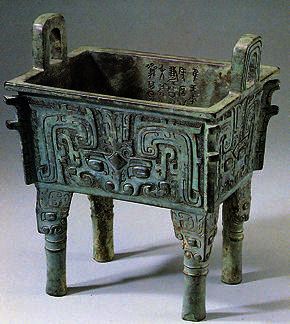
Typically, bronzes were presented by one aristocrat to another, and many bear inscriptions on the inside to the effect that "this Whats-It vessel was presented by Lord So-And-So to Lord Such-And-Such." You can glimpse such an inscription on the inside wall of the square dǐng 鼎 (or "fāng dǐng" 方鼎) shown at the right, which dates from about the 11th century BC. More often such inscriptions are on the floor of the vessel.
Classification. Because of these inscriptions, we have a long list of ancient vessel names, and we often know that a given vessel was considered to be of a certain type —such as a dǐng— because it says so. But sometimes it is hard to square such identifications with other examples with the same name, which may or may not look the same. In other words, not all similarly named vessels look quite right.
Given the huge length of time during which ritual bronzes were produced and used in China, it is not surprising that there was variation in any given named form, or that the forms often overlapped. But even accepting the variation, we seem to encounter a surprisingly large number of names for a surprisingly small number of functions.
Lost Functions. In many cases, the bronze forms were lineal descendants of earlier ceramic vessels of everyday use, and archaeologists have found pottery plates, bowls, jugs, cups, and steamers from earlier periods that would have been the models.
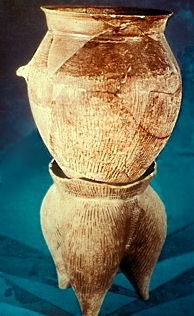
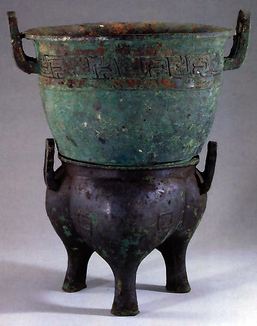 The pottery double-boiler (yǎn 甗) at the left is from the famous Neolithic site at Bànpō 半坡, dating to about 3500 BC, while the bronze one on the right dates to about 850 BC. (In both cases the top was probably not originally paired with the particular bottom displayed with it in museums today, but you get the general idea.) That is a time span of more than two and a half millennia, and if this page were about Chinese food, that would be a very big deal. For present purposes, the point is that the ritual vessels were not usually arbitrary. They had their origin in more normal kitchen equipment. But the bronze forms, once devised, tended to take on a functional and symbolic life of their own.
The pottery double-boiler (yǎn 甗) at the left is from the famous Neolithic site at Bànpō 半坡, dating to about 3500 BC, while the bronze one on the right dates to about 850 BC. (In both cases the top was probably not originally paired with the particular bottom displayed with it in museums today, but you get the general idea.) That is a time span of more than two and a half millennia, and if this page were about Chinese food, that would be a very big deal. For present purposes, the point is that the ritual vessels were not usually arbitrary. They had their origin in more normal kitchen equipment. But the bronze forms, once devised, tended to take on a functional and symbolic life of their own.
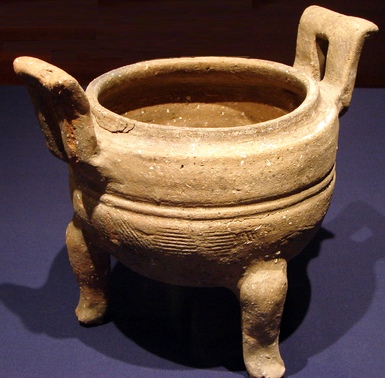

Closely similar ceramic forms continued (and still continue) to be produced, both in utilitarian and in deliberately antiquarian variants. Indeed, although bronze forms had their origins in pottery, from the time bronze vessels began to be used, they in turn were imitated in ceramic, and to this day Chinese use some of these designs, now often made of plastic, on family and temple altars (or in curio cabinets or on dining room tables) around the world. (The pottery dǐng 鼎 at left is from the Warring States Period —period 4e, about 300 BC— actually later than the bronze one at the right, which dates from a thousand years earlier.)
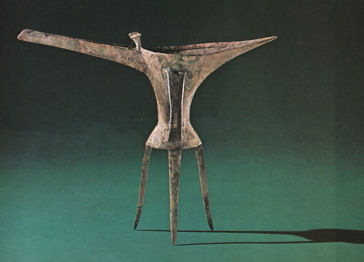
Since bronze vessels were never intended as everyday table ware, artistic concerns were primary, and some of them were exaggerated beyond usability. The very early jué 爵 at right (from the 1600s BC), for example, is too fragile for serious use, although it appeals to our modern sense of elegant proportion. In some cases excessive decoration would have rendered the vessels impractical for any but very occasional use.
Excessive Terminology. Although we know that most bronze vessels were intended for ritual use (even if they may have been displayed more than used), we do not necessarily know what the rituals in question were, or why so many different kinds of vessels were involved. Some terms may have been highly specialized (much the way modern clothing is), but some terms also seem to have been rather generic: simply plates, jugs, bowls, &c.
Experts have usually classified the vessels by their shapes, allowing their decisions to be overruled whenever a particular vessel contained a name that identified it differently. Other experts have classified them by general function, for example as "food vessels," "wine vessels," and a catch-all of "other things."
(By the way, "wine," in the case of ancient China, is a highfalutin term for beer. It was not made from fermented fruit, but from fermented grain, usually millet. And it was spiced or flavored in various ways. On this page it is called beer, although it was not a kind of beer that would appeal to modern taste. Actually, if there is a good-tasting millet beverage, I have yet to discover it.)
Many vessels for which only generic names are known are nevertheless identified in museum labels by generic Chinese terms rather than English ones. The word bēi 杯, for example, simply means "cup." But a bronze cup may still be labeled by the borrowed term "bēi" as though bēi were a specialized term. (This makes sense when it tells the viewer that an internal inscription uses that word. It seems merely pretentious otherwise.)
Animal Faces & Other Decorations. Bronze vessels were almost never left undecorated. Decorations include geometric designs and forms of animals, real or imaginary.
Although some of these are realistic, many are highly abstracted and have stimulated much learned speculation proposing classifications and interpretations. The provisional conclusion at this time as that we have no idea what was going on.
A small number of bronzes normally or often take the shapes of animals. (This is true of the yí 匜, the gōng 觥, and often the zūn 尊 forms.) But more often fierce beasts are used as all or part of the surface design.

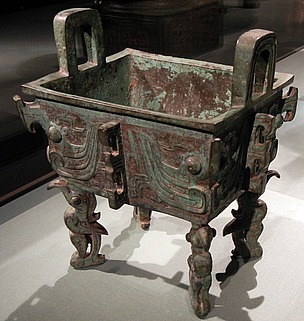
One of the most pervasive animal motifs is the ferocious but mysterious tāotiè 饕餮. Among other places, this figure appears as a face at corners of square vessels, as on the fāng dǐng 方鼎 shown at the left, or on their flat sides with a ridge of metal constituting a nose, like the one on the right.
The tāotiè may lack a jaw, but usually has fangs/teeth and horns. Often a body is stretched out in both directions from the head. There is no consensus on what, if anything, it means. (For a good time, check the Wikipedia entry for this.)
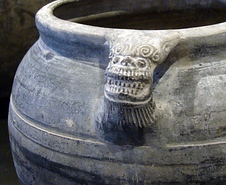
Various other fierce animals may appear as well, especially as handles —usually tigers or dragons, but sometimes rhinos, turtles, or other creatures. Some scholars have opined that the animals were symbols of social groups —logos, if you like. However that did not stop them from losing such associations and being generalized for broader use. Some of these get imitated in later ceramic works, as in the Hàn 汉 dynasty (period 6, roughly 200 BC - 200 AD) pottery vat shown at right.
This Page. This page is the culmination of many years of frustration trying to make sense of missing, incomplete, or misleading museum labels. Here you will find pictures of some of the main kinds of Chinese bronze vessels that you can see in many museums, together with their Chinese names and short descriptions to help in identifying them. They are divided into groups by their assumed function. For many bronze types, I have not found satisfactory pictures, but I have left in the names in case they are useful to somebody.
The simple line drawings are from dynastic Chinese woodblock sources. The photographs are from various museum collections. Details will be found at the end of the page.
Simplified characters are in red. When they differ, traditional characters are given in blue.
How to Study This Stuff. There is no way that an ordinary mortal will remember all these terms, especially given the vagueness with which they are applied. I recommend that you look over the page for the forms that are most interesting or that strike you as "typical" and limit yourself to three or four (eight or ten if you already know Chinese). The two most important terms to remember are probably dǐng 鼎 and jué 爵. Next in importance are probably
jiǎ 斝,
hú 壶,
and gū 觚, mostly because they are found in so many museums (including San Diego) and on art history exams. You can consider the rest of this material to be for "reference" and quit reading while you are ahead.
Return to top, index.
An interactive review quiz is available covering the introduction above. (Link) The remainder of this page is intended for occasional reference.
B. Generic Terms
Prefixes
- FĀNG 方
- Prefix meaning “square,” as in fāng dǐng 方鼎, fāng léi 方罍.
- SĀN JIǍO 三脚
- Prefix meaning “three-legged,” as in sān jiǎo dǐng 三脚鼎 a three-legged dǐng.
- SHUǏ 水
- Prefix meaning “used for water,” as in shuǐ zhù 水注, “water pitcher”
- SHÒU 兽 獸
- Prefix used for beasts of any kind used as decoration.
- XĪ 牺 犠, 羲

- Prefix meaning shaped like a generic or imaginary sacrificial animal, especially an ox, as in xī zūn 牺尊. (Some animals are imaginary, or are subjected to extreme imaginative distortion. The one shown here may or may not be an ox.)
- NIÚ 牛
- Prefix meaning ox-shaped, as in niú zūn 牛尊.
- SÌ 兕
- Prefix meaning “rhinoceros-shaped,” as in sì gōng兕觥.
- XIÀNG 象
- Prefix meaning “elephant-shaped,” as in see xiàng zūn 象尊.
- ZÚ 足
- Prefix meaning “footed,” as in zú wǎn 足碗, a footed bowl.
Return to top, index.
Generic Terms
- BĒI 杯 杯, 盃)
- Generic term for a cup.
- BŌ 钵 缽
- Generic term for a simple bowl the closes in slightly at the top, such as a monk’s begging bowl. Alternate writings may be written with the same phonetic, but with radicals jīn 金 (metal), mǐn 皿 (vessel), fǒu 缶 (ceramic), or occasionally wǎ 瓦 (tile).
- PÉN 盆
- Generic term for a bowl or basin not intended for use in eating. but for collecting, storing, or serving, whether liquids or solids, or even for washing one’s hands. For example, máo-xuě pén 毛血盆 “animal blood bowl,” i.e., a pén used to contain blood of sacrificial animals.
- PÁN 盘 盤

- Generic term for a flat or very shallow plate or tray, usually round or oblong, with or without legs or a riser.
- WǍN 碗 (椀, 盌)
- Generic term for a bowl that consistently widens toward the top, such as a rice bowl or a soup bowl.
- ZHÙ 注
- Pitcher of any kind, regardless of shape, usually in the phrase shuǐ zhù 水注, “water pitcher.” (Named after the function, not the shape, hence unidentifiable except when labeled.)
Return to top, index.
C. Solid Food
Food Preparation
- DǏNG 鼎
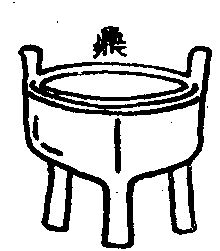
- Three-footed circular vessel probably used to cook or contain meat or perhaps sometimes as an incense burner. The circular, three-legged version may be more exactly specified as a "three-legged dǐng" (sān jiǎo dǐng 三脚鼎).
 A square version with four legs is nearly always called a "square dǐng" (fāng dǐng 方鼎. An example is shown at left. It is not clear whether there was any meaninful functional difference between the two forms.
A square version with four legs is nearly always called a "square dǐng" (fāng dǐng 方鼎. An example is shown at left. It is not clear whether there was any meaninful functional difference between the two forms.
Like the jué 爵, the dǐng is one of the most beloved of all bronze vessels, frequently reproduced from antiquity to the present. In tourist hotels across China the ice bucket often takes the form of an insulated plastic fāng dǐng. Similar ice buckets are available in Chinese curio shops around the world. You probably need one.
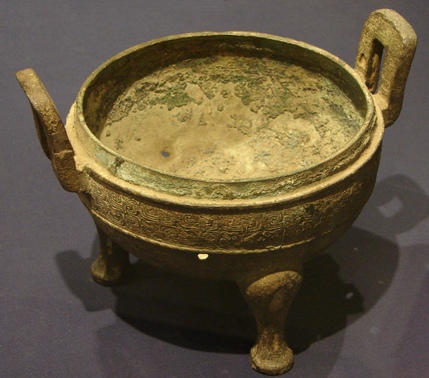

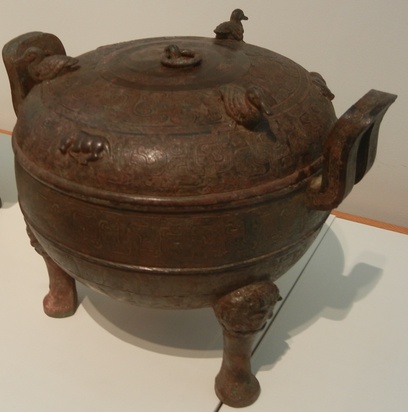

- LÌ 鬲

- Hollow-legged variant on a dǐng, a pot to cook or contain meat or porridge. The term lì-dǐng 鬲鼎 is used for one with legs hollow at the top but solid below, although one example in the National Palace Museum has extremely short legs hollow all the way, and is still called a lì-dǐng. It has been proposed that the original pottery version had hollow legs so that it could be set over a very small fire and make maximum use of the heat to boil liquid inside.
(Language note: This character is read gé in some other contexts.)


- YǍN 甗
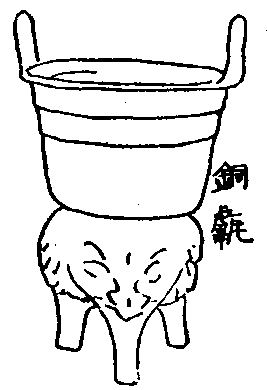
- Double boiler, usually made up of a deep bowl with three hollow, bloated legs, topped by a second vessel.
(There is virtually nothing to distinguish a yǎn from a zèng 甑.)

- ZÈNG 甑
- (1) Cooked Grain Pot. (2) Grain Steamer. (3) Distiller.
When referring to a vessel to hold cooked grain, the word zèng would seem to be virtually interchangeable with the term xín 鬵.
Some writers identify this word with distillation. Evidence is mixed about the time when distillation was discovered in China, but the process involves evaporating a liquid and re-condensing the vapors, and, like grain preparation or other kinds of cooking, this can be (better?) accomplished in a double-boiler, so some examples of ancient double boilers may have been used in distillation. In that case, there is virtually nothing that would functionally distinguish a zèng from a yǎn 甗.)
- BǏ 匕
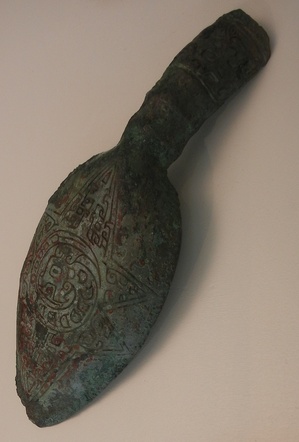
- Shoehorn-shaped spatula or shallow scoop with a hook toward the convex side at the narrow end.
- CHǍN 铲 鏟
- Spade, scoop, shovel. (Some were made of jade.)
- CHÉNG 盛
- “To pour or dump,” especially a non-liquid, and hence any container so used in ritual, regardless of shape. However a common compound is shuǐ chéng 水盛 , “water basin.”
(Language note: In modern Chinese chéng is normally a verb meaning “to fill.”)
- CHÍ 匙
- Generic term for a spoon, normally ceramic.
- DĀO 刀
- Generic term for a knife.
- DǑU 斗
- Funnel; sieve; measuring basin.
- LIÀNG 量

- A cylindrical measuring basin with a ring handle on each side.
- XÍNG 铏 鉶
- Broth caldron
- ZÀO 灶 竈, 灶
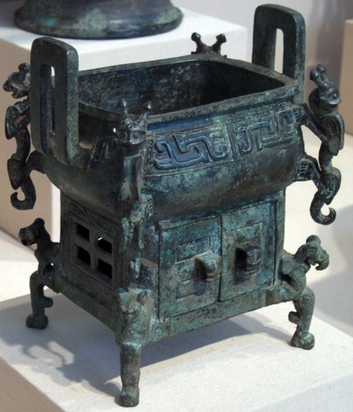
- Generic term for a stove. Some tiny, table-top models were made of bronze and may (or may not) have been used in formal cooking of food in some rituals. (Since not many of these have survived, the probability is that they were not so used, or else that the rituals that might have called for them were rare.)
Return to top, index.
Containers for Cooked Grain
- DUÌ 敦
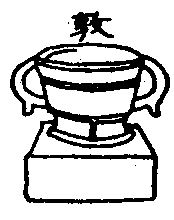
- This term seems to be associated more with the function of holding or serving cooked grain than with a specific shape. The same may be said of the guǐ 簋 (below), and grain basins in a variety of shapes may be identified by either term.
Sometimes a duì (or a guǐ) is a very flat, oblong vessel with side (not end) handles and a flat lid, with or without feet, virtually interchangeable in form with the guǐ shown below.
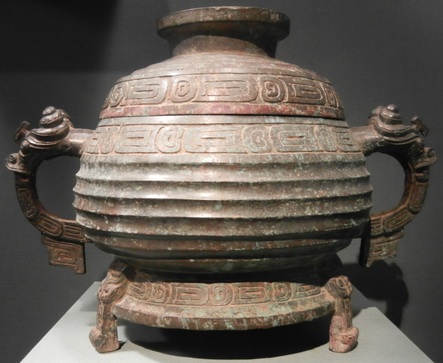
At other times, a duì (or a guǐ) may be cast onto a square, box-like riser, like the one shown here.
Still other identified examples may be close to spherical, with the lid being in effect usable as a separate dish.
A duì (or a guǐ) may have three or four legs or simply a small riser.
(Language note: This character is read dūn in other contexts.)
- GUǏ 簋

- There seems to be little about its form to distinguish a guǐ from a duì 敦 (above) Both terms designate a vessel to hold cooked grain in feasts or sacrifices, and both terms, seemingly, can be applied to a wide range of shapes in the vessels serving that function.
Many guǐ are shallow and basket-shaped, like the drawing here, although sometimes with rounded corners. Most have handles decorated by descending tabs or flaps.
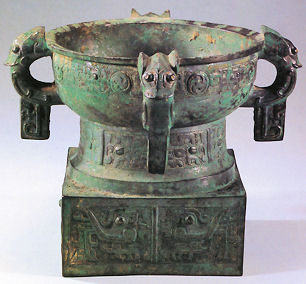
However, like duì, the term seems easily extended to bronze bowls mounted on a square base, and sometimes it is applied to vessels (like the one with silver inlay shown here) for which seem to cry out for more specific terms. The one shown attached to the high square base differs only in the number of handles from one of the duì shown just above (although it also contains a small bell, as it happens).
 The guǐ in the picture at left is clearly so identified, even though it seems to have more in common with the duì shown above than with the other guǐ shown here. These examples suggest the overlapping ranges that many of these terms have.
The guǐ in the picture at left is clearly so identified, even though it seems to have more in common with the duì shown above than with the other guǐ shown here. These examples suggest the overlapping ranges that many of these terms have.
- XÍN 鬵
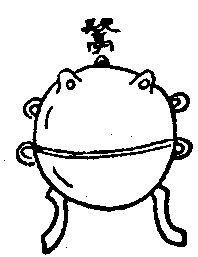
- Only the character printed above it makes this picture necessarily a xín, which appears to have been a generic term used for many kinds of basins intended to hold cooked grain. Dictionaries note that the term is effectively a pretentious term for a zèng 甑.
- FǓ 簠

- A very low, square dish with widely flaring walls on a small, low base, apparently originally modeled on a basket. Some fǔ have covers, and sometimes the cover (as here) is a mirror image of the base and can function as an independent vessel. The ideal fǔ was square outside and round inside, used to hold boiled grain in state worship.
- XǓ 盨 盨
- Broad, oval-shaped, low dish with bulging sides, and handles at the ends, something like a modern gravy boat without a spout. Most examples have a lid with circular lugs. It was used as a container for cooked grain.
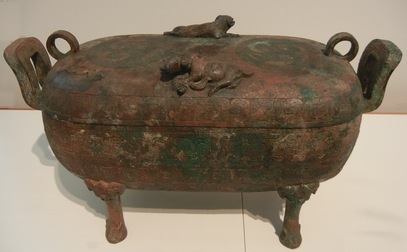
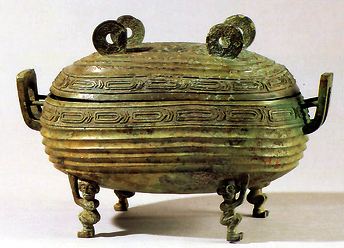
Return to top, index.
Other Concave Vessels for Food Presentation
- GUÀN 罐, 鑵, 罆 罐, 鑵, 罆)
- Generic term for a variety of shapes of pots, with or without handles, but usually with a short neck and or without a neck and usually lacking a base.
- ĀN 盦
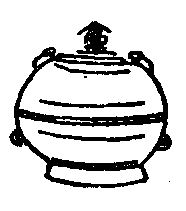
- A deep, broad-mouthed, double-channeled, footed vessel.
- BIĀN 笾 籩
- Originally a splint basket with cover, goblet shaped, used for sacrificial fruits or dried meats, occasionally imitated in bronze.
- DĒNG 登
- Covered sacrificial dish, usually of earthenware; when covered, it has the shape of a sphere on a pedestal.
- FÙ 鍑 鍑
- A pottery bowl with three legs and a lid in the general shape of a straw hat with a bead on top. Possibly identical with fǔ 簠
- LIÁN 奁 奩
- Cylinder with three feet.
(Language note: A zūn may also assume this shape.) Several slightly variant writings of the character occur.
Return to top, index.
Flat Vessels for Food Presentation
- DÒU 豆

- Shallow, platter-like chalice of wood, bronze, or porcelain, nearly always on a central high foot, used to hold and display cooked food when it is ready to eat.
- KUĪ 盔
- Round, footed, flattish “fruit basket” with no handles but with lid.
- MǏN 皿
- A shallow container, plate, saucer, dish.
(Language note: This character is radical No. 108, used in the written form of many other words related to bowls.)
- ŌU 瓯 甌
- A small tray.
(Language note: The same word is occasionally used for a cup.)
Return to top, index.
D. Vessels for Liquids
Vessels for Drinking or Pouring Libations
- JUÉ 爵
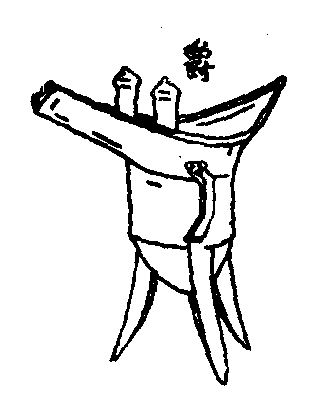
- Spouted cup used for ritual beer, always with two “antennae” on top and three feet. It is used to pour beer into a cup, but it was apparently also customary to drink directly from it. Because of its distinctive shape, the jué is perhaps the most famous of all Chinese bronze vessels, frequently reproduced for collectors in materials ranging from modern bronze to cheap plastic. Movies set in antiquity will often show jué in use in banquet scenes.
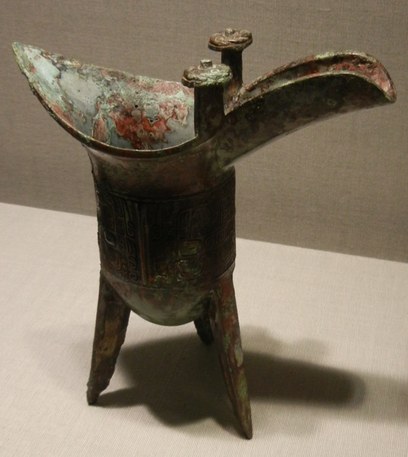

- JIǍ 斝
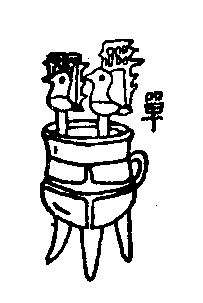
- Similar to a jué, with three legs and two “antennae,” but normally without a spout, and usually with a handle. It is believed to have been used to pour beer on the ground as a sacrifice to ancestors.


- JIǍO 角

- A vessel form, shaped like a jué 爵 but without the “antennae.” Sometimes it may have a lid. The word JIǍO literally means “horn,” but it is hard to imagine someone thinking this looks like a horn.
- ZHĪ 巵, 卮
- A roundish, bowl-shaped vessel with a circular foot and handles on either side, believed to be used as a goblet.
- ZHÌ 觯 觶

- Small —even tiny— vase from which beer is drunk, with or without a lid, often oval when viewed from the top.
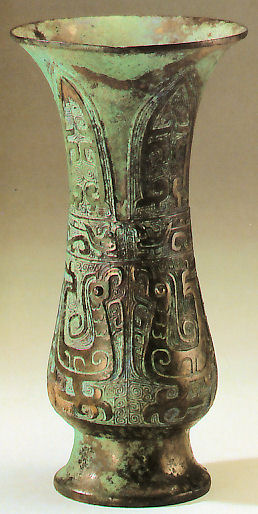 The tall one shown here is identified as a zhì, but does not conform to most descriptions.
The tall one shown here is identified as a zhì, but does not conform to most descriptions.
Return to top, index.
Utility Vessels for Liquids
- GĀNG 缸
- (1) cistern. (2) crock.
- GUÀN (PÉN) 盥 (盆)
- Flat wash basin used to rinse hands before worship.
- HÉ 盉
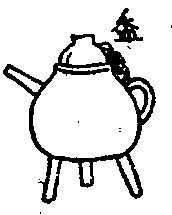
- Lidded, three-legged beer vessel with a straight spout reminiscent of a modern teapot, in which water is mixed into the beer.
(Language note: In modern Chinese a teapot is always called a hú.)
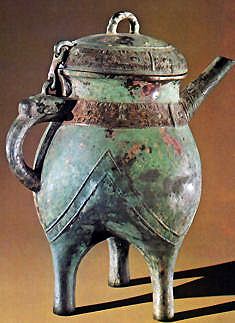
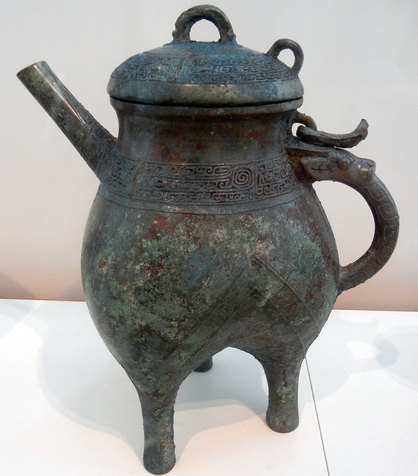
- SHÁO 勺
- Ritual beer dipper or ladle.
- XǏ 洗
- Wash-basin, typically round with a flat spot on the bottom and widely flaring sides, sometimes with two handles beneath the level of the rim. Never has feet.
- YÍ 匜
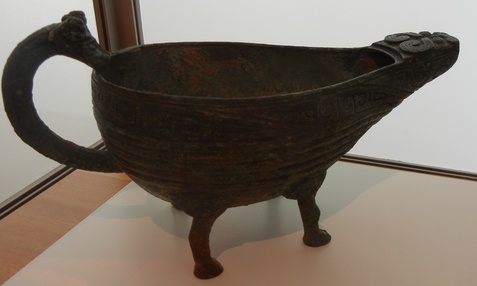
- Animal-shaped “gravy boat” sometimes with a full, covered spout and lid, nearly always with four legs from which water is poured into a pán 盘 for washing. If it was really used for washing, it would have been during a ritual, given the elaboration of these objects, which made them among the most attractive in any set of ritual tools.
(Language note: Despite identical pronunciation, this is not the same as yí 彝, a kind of goblet.)
Return to top, index.
Vessels for Presenting or Storing Liquids
- GŌNG 觥
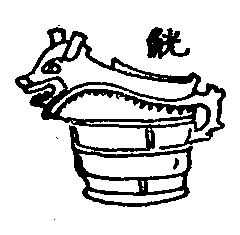
- Beer vessel, originally made of horn, later of bronze or other materials. Shaped like a modern gravy boat, but with a lid. Typically a gōng was made in an animal shape. For example, a sì gōng 兕觥 is specifically a rhinoceros-shaped gōng. Because of their appealing animal shapes, gōng are among museum favorites.
(Language note: Not read guāng!)

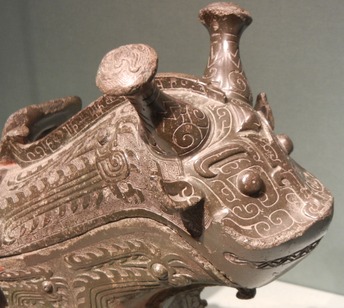
- BÙ 瓿
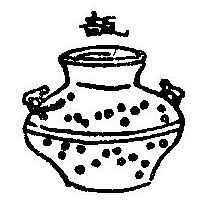
- Spherical, base-less, usually neckless, jar or pot, with small mouth and side handles, very similar to a leí, but usually without a handle. Seems to be a specialized term for a kind of guàn 罐. (Formerly also read pǒu.)
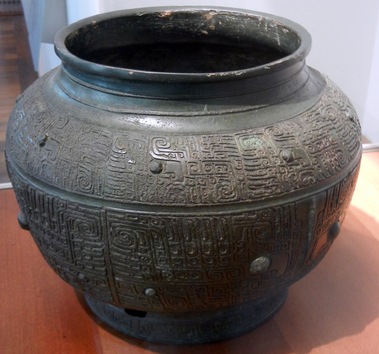
- FĀNG 钫 鈁
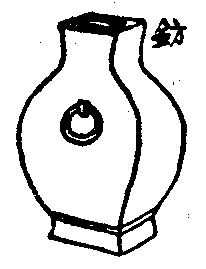
- Classic “square” Chinese bottle, square in cross section. Notice that this is not siginifently different from the square bottle shown under hú 壶. Fāng appears merely to be a specialized term for a square hú 壶.
- HÚ 壶 壺
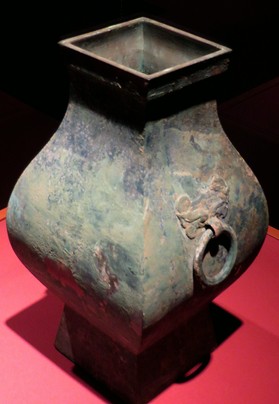
- Generic term for a jar or bottle, usually with a base and a spout in which beer is stored. (In modern times the term has come to be specialized for teapots, but this is not ancient usage.) In antiquity the term designated any of a wide range of shapes of ritual beer vessels. A hú zūn 壶尊 is specifically an urn-like jug used to hold beer to offer in worship. See note at fāng 钫.
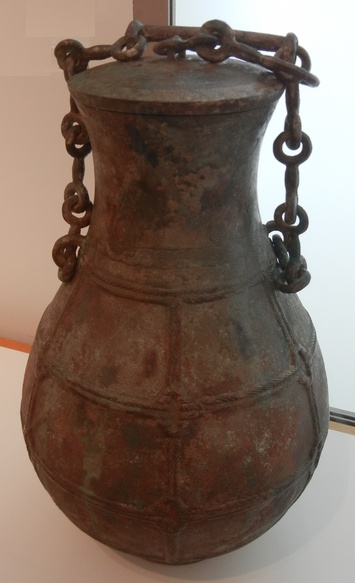
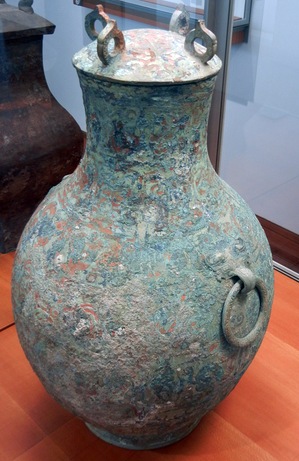
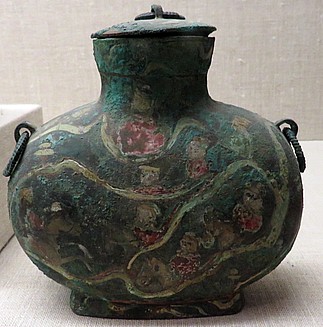
A biàn hú 遍壶 “Canteen-shaped bottle” does in fact look like a canteen and was presumably intended for transporting liquids.
- JIÀN 鉴 鑑
-

A simple, large “punch bowl” with 2 or 4 handles and either no base or four feet. It is believed that these vessels were used to hold cold water or ice to cool other vessels set into them.
(Language note: The same word is used for a mirror.)
- JIĀO 浇 澆
- Ewer or huge, narrow-necked pitcher.
- LÉI 罍
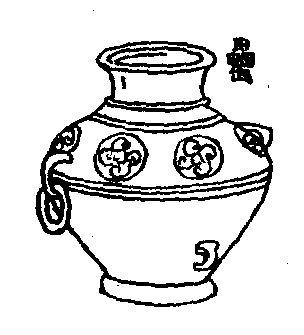
- A large broad-mouthed, pot-bellied vessel with two handles, on a stand, sometimes with a domed lid, for the storage of beer. Often it is difficult to distinguish a léi from a bù 瓿. Some specimens are square and hence called fāng leí 方罍. Possibly a later variant of the léi is the líng 瓴, although that term may be confined primarily to ceramic vessels.
- WÈNG 瓮 甕, 瓮)
- Urn, jug.
- YÍ 彝
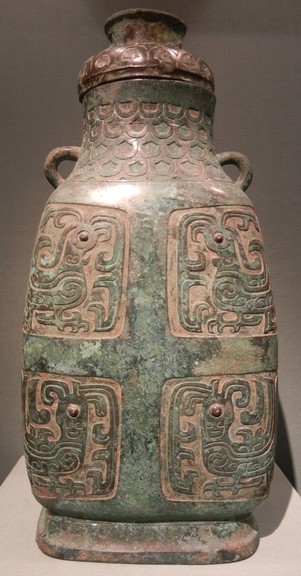
- Usually described as a “goblet,” most yí, which vary a good deal in form, are too large to imagine that they were really used for drinking. Fāng yí 方彝 A square yí beer goblet, with a lid in the shape of a roof and in most cases with corner flanges.
(Language note: Despite identical pronunciation, this is not the same as yí 匜, a “gravy-boat-shaped” covered vessel.)
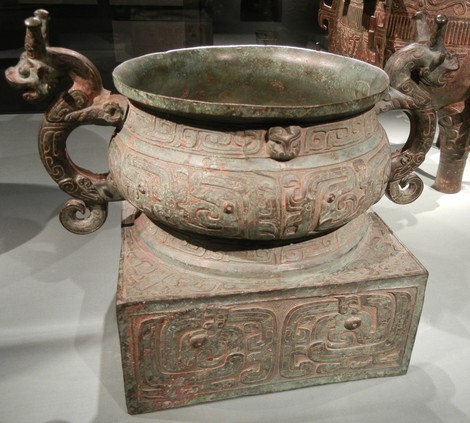
- YĪNG 罃
- Generic term for a long-necked bottle.
- YǑU 卣
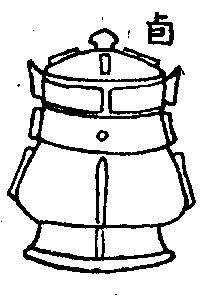
- A kind of kettle with low base, and handle that stretches across the top to lugs on two sides and a domed lid. Although it was clearly used for beer, it may have been specialized to a particular kind of spiced beer.

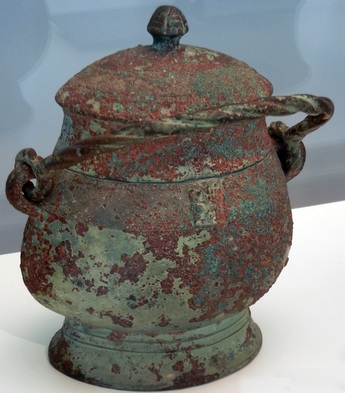
- YÚ 盂
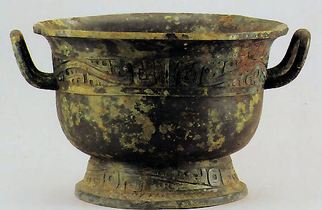
- Basin, usually a large, deep “punch-bowl” with flaring rim, stand, and two rigid, rising handle loops fastened below the rim; apparently a large-sized cross-over container for cooked grain or water. Some examples have a flaring rim, others close slightly toward the top. Most are mounted on a low riser.
- ZHŌNG 钟 鐘
- Pot-bellied vase with or without two ring handles; it usually has a body in a perfect sphere with a tall spout rising from it, producing a bottle with a long neck and little or no base. Indistinguishable from a similarly shaped hú.
(Language note: The same word is used for “bell.” )
- ZHŌU 舟
- Small, lightly footed vessel reminiscent of a modern coffee cup, without the modern handle, but with very small side handles.
(Language note: The word in other contexts refers to a small boat.)
- ZŪN 尊

- Large or medium-sized ritual beer vessel in a variety of forms, often including animal shapes, such as an elephant (xiàng zūn 象尊) or an ox (niú zūn 牛尊). The most basic zūn is spittoon-shaped, and some were apparently even used for that purpose. A particularly large one may be called a zhù zūn (zhuó zūn) 箸尊.
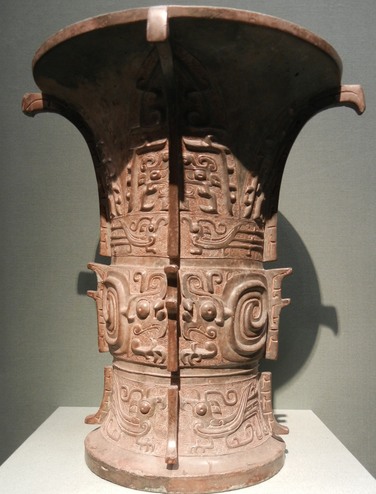
- ZŪN 樽
- The character is probably merely a graphic variant for zūn 尊, it’s phonetic. However, the term is used at the National Palace Museum specifically for a ceramic beer vessel in cylindrical form with three legs and a conical lid.
Return to top, index.
Vessels Probably Used as Flower Vases
- GŪ 觚
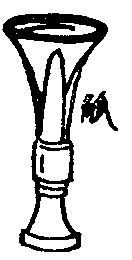
- Very large, tall vessel with a flaring top, traditionally said to be a particularly impractical drinking cup. However its very large size makes this less probable than its use as a flower vase, which is how reproductions of this form are used today.
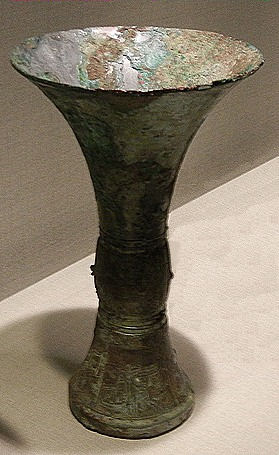
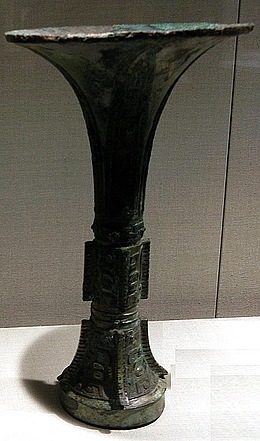
- DUĀN 端 耑
- Tall, elongated vase.
(Language note: This is a rare case in which the “simplified” character is more elaborate than the traditional one.)
- PÍNG 瓶
- Vase with tall, narrow neck and flaring lip at the top. In modern Chinese this has been generalized to all flower vases.
Return to top, index.
E. Other Common Bronze Implements
Incense Burners
- LÚ 炉 爐, 鑪)
- Incense censer, regardless of shape.
Long after the end of the Bronze Age (even up to the present) reproductions of many different bronze vessels were used as antiquarian incense burners.
- XŪN 熏 薰
- To perfume, hence a term used for any implement which may be used to perfume, including incense burners.
Return to top, index.
Musical Instruments
- GǓ 鼓
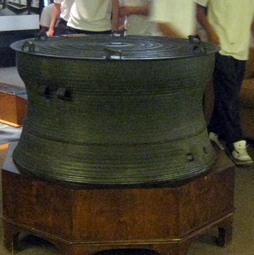
-
Any sort of drum. The most important bronze ones come in a range of sizes and usually date from the Hàn 汉 dynasty (period 6, roughly 200 BC to 200 AD). They are often quite large, like the one shown here from Chicago's Field Museum, where it has been an object of eager pounding for generations of school-age visitors (including me as a kid). Similar drums were produced especially in south China and southeast Asia.
(Most museums don't let kids whack at their drums, and they are probably right. But the Chicago drum seems to be surviving just fine. It is cast metal after all, and it was originally made to be pounded!)
- ZHŌNG 钟 鐘

- A “bell,” sometimes suspended with the open end downward and sometimes positioned with the open end at the top. Chinese bells were played by striking from the outside with a wooden hammer.
(Language note: The same word is used for a kind of bottle.)
- BIĀN ZHŌNG 编钟 編鐘
- Chime set of tuned bells suspended in rows to be struck by hammers. Sets of various sizes have been found containing up to sixteen bells. Each of the bells shown here can play two notes, depending upon where it is struck, so the set of seven is potentially a set of fourteen notes.

- CHÚN 錞 錞
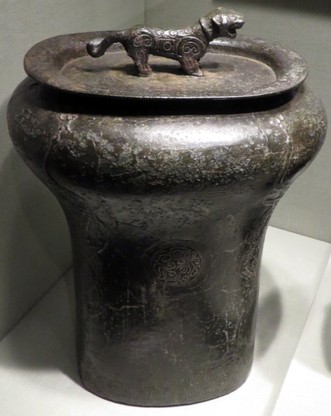
- A “small mouthed” bell, played with the opening toward the bottom and suspended by a toggle or sculpture on the slightly bulbous top.
- BIĀN QÌNG 编磬 編磬
- Chime of sixteen musical stones suspended in two rows.
- NÁO 铙 鐃
- Percussion instrument, probably a carriage bell
Return to top, index.
Miscellaneous Tools
- JIÀN 鉴 鑑
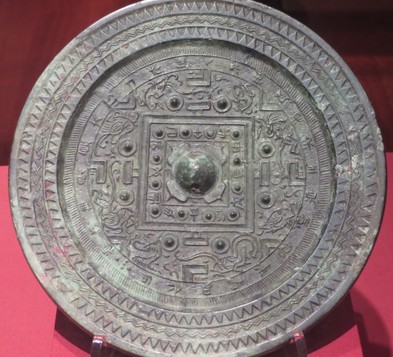
- Mirror.
In no part of the ancient world were there mirrors that anybody would want to use today, and bronze mirrors were by no means the best of them, at least if modern attempts at reproducing them are to be trusted.
They were, however, shiny, which made them interesting enough to give them cosmic associations. They may have been used in exorcism, but a large number of them also have clearly religious (Daoist) symbols on the "back" (non-flat) side. The handle was apparently a cord passed through a hole across the lump in the center.
(Language note: the same word is used for a kind of “punch bowl.”)
- DĒNG 灯 燈
- Oil lamp, regardless of shape.
- GǍO 镐 鎬
- A kind of hoe
- GŌU 钩 鉤
- Generic term for a hook
- HÉ 盒
- Generic term for a box. Although the box theoretically can be made of bronze, the term normally includes small ceramic or lacquer boxes designed to hold cosmetics, pins, small desk objects, and the like.
Return to top, index.
Bronze Weapons
- DUÌ 镦 鐓
- Butt and ferrule for spear handle.
- FŪ 鈇 鈇
- Ax or hatchet. Contrasts with yuè, a large ax.
- GĒ 戈
- Dagger-axe or halberd
- JIÀN 箭
- Arrow
- JIÀN 剑 劍, 劎
- Double-edged sword
- MÁO 茅
- Spear, spear head
-
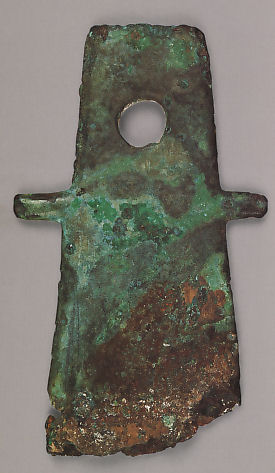 YUÈ 钺 鉞
YUÈ 钺 鉞 -
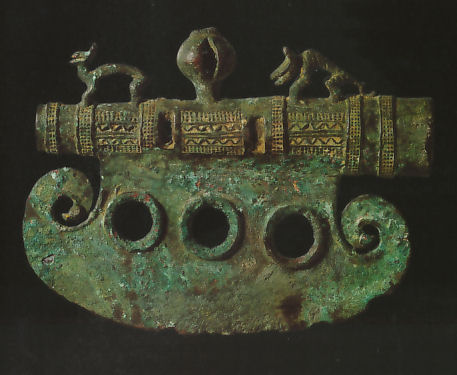 Large ax. Contrasts with fū, a small ax. Although bronze actions can be functional, they competed poorly with stone and eventually iron, so even when undecorated, like the one on the right, it seems likely that they were ceremonial. the heavily decorated one here was clearly intended as a prestigious work of art, not intended for actual use except perhaps in a rare and purely ritual context.
Large ax. Contrasts with fū, a small ax. Although bronze actions can be functional, they competed poorly with stone and eventually iron, so even when undecorated, like the one on the right, it seems likely that they were ceremonial. the heavily decorated one here was clearly intended as a prestigious work of art, not intended for actual use except perhaps in a rare and purely ritual context.
Return to top, index.
F. Sources
1. The line drawings are from dynastic Chinese sources. They are reprinted from:
- IOKA Sohō 井岡咀方
- 1942 Manshi shūzoku kō 滿支習俗考 (An inquiry into Manchurian customs). Reprinted 1975 Táiběi 台北 : Gǔtíng shūwū 古亭書屋. Pp. 421-429. Ioka does not cite his Chinese source.
- Anonymous
- 1749-1793 Mirror of the Western Qīng 西清古鉴/西清古鑑 a catalog (in 40 volumes plus supplements) of the imperial collection. (Wikipedia Link). Quoted in W.M. Hawley 1946 Chinese Bronzes. Hollywood: Privately published.
2. The photographs show objects from the collections of various museums. Unless you are viewing this page on a tablet, passing your mouse over a picture will show the source of each illustration. Many museums around the world have wonderful collections, and you are encouraged to visit them when you have opportunity.
Return to top, index.



 Bronze was developed to a very high level of technical and artistic sophistication in Shāng 商 and Zhōu 周 times in China —periods 03 and 04, roughly the millennium and a half from 1750-250 BC— but the objects made were only rarely of much use in the work-a-day world. Magnificence, instead, was the order of the day, or more exactly the centuries. Some, like the guǐ 簋 shown here, were even inlayed with silver or gold.
Bronze was developed to a very high level of technical and artistic sophistication in Shāng 商 and Zhōu 周 times in China —periods 03 and 04, roughly the millennium and a half from 1750-250 BC— but the objects made were only rarely of much use in the work-a-day world. Magnificence, instead, was the order of the day, or more exactly the centuries. Some, like the guǐ 簋 shown here, were even inlayed with silver or gold.

 The pottery double-boiler (yǎn 甗) at the left is from the famous Neolithic site at Bànpō 半坡, dating to about 3500 BC, while the bronze one on the right dates to about 850 BC. (In both cases the top was probably not originally paired with the particular bottom displayed with it in museums today, but you get the general idea.) That is a time span of more than two and a half millennia, and if this page were about Chinese food, that would be a very big deal. For present purposes, the point is that the ritual vessels were not usually arbitrary. They had their origin in more normal kitchen equipment. But the bronze forms, once devised, tended to take on a functional and symbolic life of their own.
The pottery double-boiler (yǎn 甗) at the left is from the famous Neolithic site at Bànpō 半坡, dating to about 3500 BC, while the bronze one on the right dates to about 850 BC. (In both cases the top was probably not originally paired with the particular bottom displayed with it in museums today, but you get the general idea.) That is a time span of more than two and a half millennia, and if this page were about Chinese food, that would be a very big deal. For present purposes, the point is that the ritual vessels were not usually arbitrary. They had their origin in more normal kitchen equipment. But the bronze forms, once devised, tended to take on a functional and symbolic life of their own.













 A square version with four legs is nearly always called a "square dǐng" (fāng dǐng 方鼎. An example is shown at left. It is not clear whether there was any meaninful functional difference between the two forms.
A square version with four legs is nearly always called a "square dǐng" (fāng dǐng 方鼎. An example is shown at left. It is not clear whether there was any meaninful functional difference between the two forms.
















 The guǐ in the picture at left is clearly so identified, even though it seems to have more in common with the duì shown above than with the other guǐ shown here. These examples suggest the overlapping ranges that many of these terms have.
The guǐ in the picture at left is clearly so identified, even though it seems to have more in common with the duì shown above than with the other guǐ shown here. These examples suggest the overlapping ranges that many of these terms have.













 The tall one shown here is identified as a zhì, but does not conform to most descriptions.
The tall one shown here is identified as a zhì, but does not conform to most descriptions.































 YUÈ 钺 鉞
YUÈ 钺 鉞 Large ax. Contrasts with fū, a small ax. Although bronze actions can be functional, they competed poorly with stone and eventually iron, so even when undecorated, like the one on the right, it seems likely that they were ceremonial. the heavily decorated one here was clearly intended as a prestigious work of art, not intended for actual use except perhaps in a rare and purely ritual context.
Large ax. Contrasts with fū, a small ax. Although bronze actions can be functional, they competed poorly with stone and eventually iron, so even when undecorated, like the one on the right, it seems likely that they were ceremonial. the heavily decorated one here was clearly intended as a prestigious work of art, not intended for actual use except perhaps in a rare and purely ritual context.